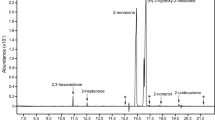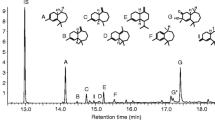Abstract
Five doses of lanierone (2-hydroxy-4,4,6-trimethyl-2,5-cyclohexadien-1-one) were tested with one dose of enantiomerically pure [99.4% (4R)-(−)] ipsdienol (2-methyl-6-methylene-2,7-octadien-4-ol) for activity as an aggregation pheromone ofIps pini (Say) in California. The response ofI. pini to 1 mg/day ipsdienol + 20 μg/day lanierone was significantly greater than the response to ipsdienol alone, but the response pattern did not demonstrate a clear dose-response relationship. The response to the highest dose of lanierone (2 mg/day) was significantly lower than the response to ipsdienol alone. Ipsdienol attracted significantly moreI. pini than a male-infested log. Lanierone did not alter the percentage of maleI. pini responding to ipsdienol alone. Neither sex ofI. pini orDendroctonus brevicomis LeConte from California produced detectable amounts of lanierone, but myrcene-aerated maleD. brevicomis produced 97.8%-(4S)-(+)-ipsdienol. The black-bellied clerid,Enoclerus lecontei (Wolcott) (Coleoptera: Cleridae) was attracted to lanierone when released with ipsdienol. Neither compound was attractive when released alone, proving synergism for the kairomone of this predator. Lanierone did not influence the response of the predatorsTemnochila chlorodia (Mannerheim) (Coleoptera: Trogositidae) andEnoclerus sphegeus (F.) (Coleoptera: Cleridae), which were attracted to all treatments containing ipsdienol.Tomicobia tibialis Ashmead (Hymenoptera: Pteromalidae) responded in significantly greater numbers to the male-infested log than it did to ipsdienol or ipsdienol + 20 μg/day lanierone.
Similar content being viewed by others
References
Barron, J.R. 1971. A revision of the Trogositidae of America north of Mexico (Coleoptera: Cleroidea).Mem. Entomol. Soc. Can. 75:1–143.
Bedard, W.D. 1965. The biology ofTomicobia tibialis (Hymenoptera: Pteromalidae) parasitizingIps confusus (Coleoptera: Scolytidae) in California.Contrib. Boyce Thompson Inst. 23:77–82.
Bedard, W.D., Tilden, P.E., Wood, D.L., Silverstein, R.M., Brownlee, R.G., andRodin, J.O. 1969. Western pine beetle: Field response to its sex pheromone and a synergistic host terpene, myrcene.Science 164:1284–1285.
Bedard, W.D., Wood, D.L., Tilden, P.E., Lindahl, K.Q., Silverstein, R.M., andRodin, J.O. 1980. Field responses of the western pine beetle and one of its predators to host- and beetleproduced compounds.J. Chem. Ecol. 6:625–641.
Birch, M.C., andWood, D.L. 1975. Mutual inhibition of the attractant pheromone response by two species ofIps (Coleoptera: Scolytidae).J. Chem. Ecol. 1:101–113.
Birch, M.C., Light, D.M., Wood, D.L., Browne, L.E., Silverstein, R.M., Bergot, B.J., Ohloff, G., West, J.R., andYoung, J.C. 1980. Pheromonal attraction and allomonal interruption ofIps pini in California by the two enantiomers of ipsdienol.J. Chem. Ecol. 6:703–717.
Bright, D.E. 1976. The Insects and Arachnids of Canada, Part 2. The Bark Beetles of Canada and Alaska. Canada Department of Agriculture Publication 1576, 241 pp.
Browne, L.E. 1972. An emergence cage and refrigerated collector for wood-boring insects and their associates.J. Econ. Entomol. 65:1499–1501.
Byers, J.A. 1982. Male-specific conversion of the host plant compound, myrcene, to the pheromone, (+)-ipsdienol, in the bark beetle,Dendroctonus brevicomis.J. Chem. Ecol. 8:363–371.
Byers, J.A., andWood, D.L. 1980. Interspecific inhibition of the response of the bark beetles,Dendroctonus brevicomis andIps paraconfusus, to their pheromones in the field.J. Chem. Ecol. 6:149–164.
Byers, J.A., Wood, D.L., Craig, J., andHendry, L.B. 1984. Attractive and inhibitory pheromones produced in the bark beetle,Dendroctonus brevicomis, during host colonization: Regulation of inter- and intraspecific competition.J. Chem. Ecol. 10:861–877.
Byrne, K.J., Gore, W.E., Pierce, G.T., andSilverstein, R.M. 1975. Porapak-Q collection of airborne organic compounds serving as models for insect pheromones.J. Chem. Ecol. 1:1–7.
Ciesla, W.M. 1988. Pine bark beetles: A new pest management challenge for Chilean foresters.J. For. 86:27–31.
Critchfield, W.B. 1957. Geographic variation inPinus conforta. Maria Moors Cabot Foundation Publication No. 3. 118 pp.
Critchfield, W.B. 1985. The late Quaternary history of lodgepole and jack pines.Can. J. For. Res. 15:749–772.
Draper, N.R., andSmith, H. 1981. Applied Regression Analysis. John Wiley & Sons, New York, 709 pp.
Furniss, M.M., andLivingston, R.L. 1979. Inhibition by ipsenol of pine engraver attraction in northern Idaho.Environ. Entomol. 8:369–372.
Furniss, R.L., andCarolin, V.M. 1977. Western forest insects. USDA Forest Service Miscellaneous Publication No. 1339, 654 pp.
Gahan, A.B. 1938. Notes on some genera and species of Chalcidoidea (Hymenoptera).Proc. Entomol. Soc. Wash. 40:219–223.
Herbert, F.B. 1916. Biological notes on certain western species of the genusIps (DeGeer). USDA Bureau Entomology and Plant Quarantine Unpublished Report, 44 pp.
Herms, D.A., Haack, R.A., andAyres, B.D. 1991. Variation in semiochemical-mediated preypredator interaction:Ips pini (Scolytidae) andThanasimus dubius (Cleridae).J. Chem. Ecol. 17:515–524.
Hopping, G.R. 1964. The North American species in group IV and V ofIps DeGeer.Can. Entomol. 96:970–978.
Kohnle, U., andVité, J.P. 1984. Bark beetle predators: Strategies in the olfactory perception of prey species by cierid and trogositid beetles.Z. Angew. Entomol. 98:504–505.
Lanier, G.N. 1972. Biosystematics of the genusIps (Coleoptera: Scolytidae) in North America. Hopping's Groups IV and X.Can. Entomol. 104:361–388.
Lanier, G.N., andBurkholder, W.E. 1974. Pheromones in speciation of Coleoptera, pp. 161–189,in M.C. Birch (ed.).Pheromones. North Holland, Amsterdam.
Lanier, G.N., Birch, M.C., Schmitz, R.F., andFurniss, M.M. 1972. Pheromones ofIps pini (Coleoptera: Scolytidae): Variation in response among three populations.Can. Entomol. 104:1917–1923.
Lanier, G.N., Claesson, A., Stewart, T., Piston, J., andSilverstein, R.M. 1980.Ips pini; The basis for interpopulational differences in pheromone biology.J. Chem. Ecol. 6:677–687.
Lanier, G.N., Teale, S.A., andPajares, J.A. 1991. Biosystematics of the genusIps (Coleoptera: Scolytidae) in North America: Review of theIps calligraphus group.Can. Entomol. 123:1103–1124.
Lehmann, E.L. 1975. Nonparametrics: Statistical Methods Based on Ranks. Holden-Day, San Francisco, 457 pp.
Lindgren, B.S. 1983. A multiple funnel trap for scolytid beetles (Coleoptera).Can. Entomol. 115:299–302.
Mathews, J.V. 1979. Tertiary and quaternary environments: Historical background for an analysis of the Canadian insect fauna, pp. 31–86,in H.V. Danks (ed.).Canada and its Insect Fauna. Memoirs of the Entomological Society of Canada, No. 108.
Miller, D.R. 1990. Reproductive and ecological isolation: Community structure in the use of semiochemicals by pine bark beetles (Coleoptera: Scolytidae). PhD thesis. Simon Fraser University, Bumaby, British Columbia. 166 pp.
Miller, D.R., andBorden, J.H. 1990.β-Phellandrene: Kairomone for pine engraver,Ips pini (Say) (Coleoptera: Scolytidae).J. Chem. Ecol. 16:2519–2531.
Miller, D.R., Borden, J.H., andSlessor, K.N. 1989. Inter- and intrapopulation variation of the pheromone, ipsdienol produced by male pine engravers,Ips pini (Say) (Coleoptera: Scolytidae).J. Chem. Ecol, 15:233–247.
Papp, C.S. 1960. The Cleridae of North America. Part I. The geographical distribution of Cleridae of North America, north of the Panama Canal.Bull South. Calif. Acad. Sci. 59:76–88.
Payne, T.L., Dickens, J.C., andRicherson, J.V. 1984. Insect predator-prey coevolution via enantiomeric specificity in a kairomone-pheromone system.J. Chem. Ecol. 10:487–492.
Person, H.L. 1940. The cleridThanasimus lecontei (Wolc.) as a factor in the control of the western pine beetle.J. For. 38:390–396.
Raffa, K.F. 1991. Temporal and spatial disparities among bark beetles, predators, and associates responding to synthetic bark beetle pheromones:Ips pini (Coleoptera: Scolytidae) in Wisconsin.Environ. Entomol. 20:1665–1679.
Raffa, K.F., andKlepzig, K.D. 1989. Chiral escape of bark beetles from predators responding to a bark beetle pheromone.Oecologia 80:566–569.
Reid, R.W. 1957. The bark beetle complex associated with lodgepole pine slash in Alberta Part II-Notes on the biologies of several hymenopterous parasites.Can. Entomol. 89:5–8.
Rice, R.E. 1968. Observations on host selection byTomicobia tibialis Ashmead (Hymenoptera: Pteromalidae).Contrib. Boyce Thompson Inst. 24:53–56.
Rice, R.E. 1969. Response of some predators and parasites ofIps confusus (LeC.) (Coleoptera: Scolytidae) to olfactory attractants.Contrib. Boyce Thompson Inst. 24:189–194.
Ross, H.H. 1955. The taxonomy and evolution of the sawfly genusNeodiprion.For. Sci. 1:196–209.
Seybold, S.J.,Yokokawa, Y.,Kubo, I.,Tupy, J.L., andWood, D.L. 1992a. Analytical resolution of the enantiomers of the aggregation pheromone components ofIps spp. (Coleoptera: Scolytidae) by direct injection on capillary gas chromatography.J. Chromatogr. In manuscript.
Seybold, S.J.,Ohtsuka, T.,Wood, D.L., andKubo, I. 1992b. The enantiomeric composition of ipsenol and ipsdienol from selected species in the subgeneric groups ofIps (Coleoptera: Scolytidae).J. Chem. Ecol. In manuscript.
Seybold, S.J.,Yokokawa, Y.,Chaudhuri, S.K.,Kubo, I.,Ohtsuka, T.,Nomura, M., andWood, D.L. 1992c. Preparative resolution and confirmation of absolute configuration of enantiopure ipsdienol.Tetrahedron Asymmetry. In manuscript.
Seybold, S.J.,Wood, D.L.,Ohtsuka, T.,Nomura, M.,Kubo, I., andSchultz, M.E. 1992d. The response of the pine engraver,Ips pini (Say) (Coleoptera: Scolytidae) and its insectan associates to the pure enantiomers of ipsdienol in California.J. Chem. Ecol. In manuscript.
Silverstein, R.M., Rodin, J.O., andWood, D.L. 1966. Sex attractants in frass produced by maleIps confusus in ponderosa pine.Science 154:509–510.
Stephen, F.M., andDahlsten, D.L. 1976. The arrival sequence of the arthropod complex following attack byDendroctonus brevicomis (Coleoptera: Scolytidae) in ponderosa pine.Can. Entomol. 108:283–304.
Stewart, T.E. 1975. Volatiles isolated fromIps pini: Isolation, identification, enantiomeric composition, biological activity, and the enantiomeric composition of other insect pheromone alcohols and bicyclic ketals. MSc thesis. College of Environmental Science and Forestry, SUNY, Syracuse, New York, 135 pp.
Struble, G.R. 1942. Biology of two native coleopterous predators of the mountain pine beetle in sugar pine.Pan-Pac. Entomol. 18:97–107.
Teale, S.A. 1990. Ecology and evolution of pheromone communication inIps pini (Coleoptera: Scolytidae). PhD thesis. SUNY, Syracuse, New York. 109 pp.
Teale, S.A., andLanier, G.N. 1991. Seasonal variability in response ofIps pini (Coleoptera: Scolytidae) to ipsdienol in New York.J. Chem. Ecol. 17:1145–1158.
Teale, S.A., Webster, F.X., Zhang, A., andLanier, G.N. 1991. Lanierone: A new pheromone component fromIps pini (Coleoptera: Scolytidae) in New York.J. Chem. Ecol. 17:1159–1176.
Vité, J.P., andGara, R.I. 1962. Volatile attractants from ponderosa pine attacked by bark beetles (Coleoptera: Scolytidae).Contrib. Boyce Thompson Inst. PL Res. 21:251–273.
Vité, J.P., andPitman, G.B. 1969. Insect and host odors in the aggregation of the western pine beetle.Can. Entomol. 101:113–117.
Wood, D.L. 1970. Pheromones of bark beetles, pp. 301–316,in D.L. Wood, R.M. Silverstein, M. Nakajima (eds.). Control of Insect Behavior, Academic Press, New York.
Wood, D.L., andStark, R.W. 1968. The life history ofIps calligraphus (Coleoptera: Scolytidae) with notes on its biology in California.Can. Entomol. 100:145–151.
Wood, D.L., Browne, L.E., Bedard, W.D., Tilden, P.E., Silverstein, R.M., andRodin, J.O. 1968. Response ofIps confusus to synthetic sex pheromones in nature.Science 159:1373–1374.
Wood, S.L. 1982. The bark and ambrosia beetles of North and Central America (Coleoptera: Scolytidae), a taxonomic monograph.Great Basin Nat. No. 6, 1359 pp.
Young, J.C., Brownlee, R.G., Rodin, J.O., Hildebrand, D.N., Silverstein, R.M., Wood, D.L., Birch, M.C., andBrowne, L.E. 1973. Identification of linalool produced by two species of bark beetles of the genusIps.J. Insect Physiol. 193:1615–1622.
Author information
Authors and Affiliations
Rights and permissions
About this article
Cite this article
Seybold, S.J., Teale, S.A., Wood, D.L. et al. The role of lanierone in the chemical ecology ofIps pini (Coleoptera: Scolytidae) in California. J Chem Ecol 18, 2305–2329 (1992). https://doi.org/10.1007/BF00984952
Received:
Accepted:
Issue Date:
DOI: https://doi.org/10.1007/BF00984952




